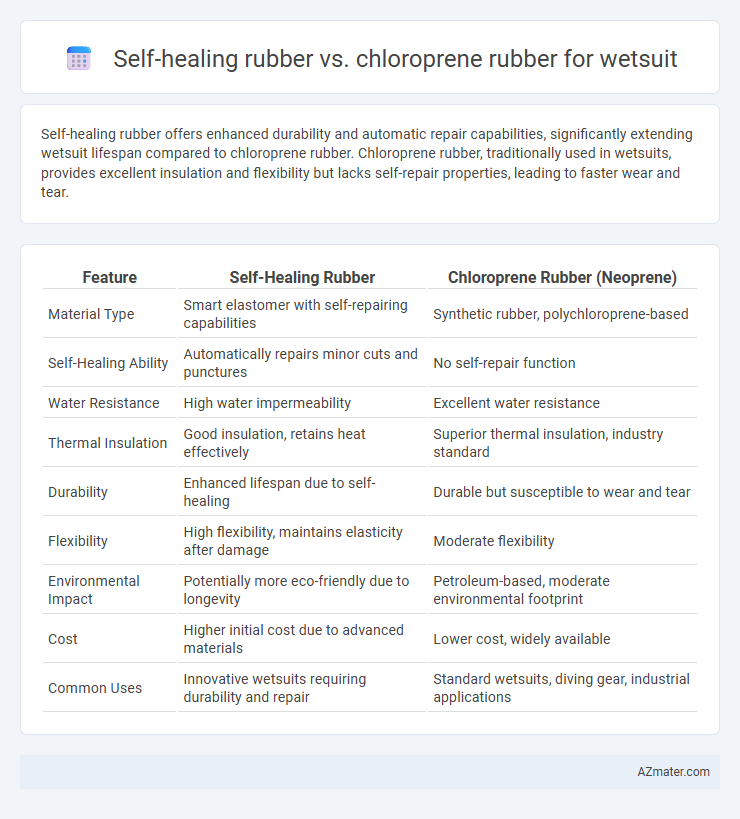Self-healing rubber offers enhanced durability and automatic repair capabilities, significantly extending wetsuit lifespan compared to chloroprene rubber. Chloroprene rubber, traditionally used in wetsuits, provides excellent insulation and flexibility but lacks self-repair properties, leading to faster wear and tear.
Table of Comparison
| Feature | Self-Healing Rubber | Chloroprene Rubber (Neoprene) |
|---|---|---|
| Material Type | Smart elastomer with self-repairing capabilities | Synthetic rubber, polychloroprene-based |
| Self-Healing Ability | Automatically repairs minor cuts and punctures | No self-repair function |
| Water Resistance | High water impermeability | Excellent water resistance |
| Thermal Insulation | Good insulation, retains heat effectively | Superior thermal insulation, industry standard |
| Durability | Enhanced lifespan due to self-healing | Durable but susceptible to wear and tear |
| Flexibility | High flexibility, maintains elasticity after damage | Moderate flexibility |
| Environmental Impact | Potentially more eco-friendly due to longevity | Petroleum-based, moderate environmental footprint |
| Cost | Higher initial cost due to advanced materials | Lower cost, widely available |
| Common Uses | Innovative wetsuits requiring durability and repair | Standard wetsuits, diving gear, industrial applications |
Introduction to Wetsuit Materials
Self-healing rubber enhances wetsuit durability by automatically repairing minor cuts and abrasions, extending the gear's lifespan and maintaining insulation in harsh marine environments. Chloroprene rubber, known commercially as neoprene, remains the industry standard due to its superior flexibility, thermal insulation, and water resistance essential for active water sports. Comparing these materials highlights self-healing rubber's innovative potential to reduce wetsuit maintenance while chloroprene ensures reliable performance in diverse underwater conditions.
What is Self-Healing Rubber?
Self-healing rubber is an advanced elastomer designed to automatically repair minor damages like cuts or punctures, extending the lifespan of wetsuits by maintaining their waterproof and insulating properties. Unlike traditional chloroprene rubber, which relies solely on its intrinsic durability and chemical resistance, self-healing rubber incorporates reversible chemical bonds or microcapsules that enable the material to restore its structure. This technology significantly reduces maintenance needs and enhances wetsuit performance in demanding aquatic environments.
Overview of Chloroprene Rubber (Neoprene)
Chloroprene rubber, commonly known as Neoprene, is a synthetic elastomer renowned for its excellent flexibility, durability, and resistance to water, oils, and temperature variations, making it the preferred material for wetsuits. Its closed-cell foam structure provides effective insulation and buoyancy, enhancing thermal protection for divers and surfers in cold water environments. Compared to self-healing rubber, Neoprene's proven water resistance and mechanical stability under prolonged exposure dominate wetsuit manufacturing due to its reliable performance and cost-effectiveness.
Durability and Longevity: A Comparative Analysis
Self-healing rubber in wetsuits offers enhanced durability by autonomously repairing small cuts and abrasions, significantly extending the material's lifespan compared to chloroprene rubber. Chloroprene rubber, known for its resistance to weathering and chemical stability, provides robust long-term performance but lacks the self-repair properties that mitigate damage accumulation. Consequently, wetsuits made from self-healing rubber demonstrate superior longevity through continuous maintenance of material integrity under harsh marine conditions.
Flexibility and Comfort in Water
Self-healing rubber enhances wetsuit flexibility by allowing micro-tears to repair quickly, maintaining elasticity and preventing stiffness during prolonged water activities. Chloroprene rubber, commonly used in wetsuits, offers excellent flexibility but lacks the ability to recover from damage, which can reduce comfort over time as the material degrades. The improved durability and sustained softness of self-healing rubber significantly elevate comfort levels in aquatic environments by preserving a snug, flexible fit throughout extended use.
Repair and Maintenance Requirements
Self-healing rubber wetsuits require minimal maintenance due to their ability to automatically repair minor cuts and abrasions, significantly extending the suit's lifespan without frequent manual patches. Chloroprene rubber wetsuits, while durable and offering good flexibility, demand regular inspection and manual repairs using adhesive patches or specialized glues to maintain waterproof integrity and prevent degradation. Choosing self-healing rubber reduces downtime and repair costs, making it a superior choice for users seeking low-maintenance wetsuit solutions.
Insulation and Thermal Performance
Self-healing rubber offers enhanced durability in wetsuits by autonomously repairing micro-tears, maintaining consistent insulation and thermal performance over time. Chloroprene rubber, widely used in traditional wetsuits, provides excellent thermal insulation due to its closed-cell foam structure that traps heat effectively. While chloroprene ensures reliable warmth in cold water, self-healing rubber extends the wetsuit's lifespan without compromising thermal protection under wet conditions.
Environmental Impact and Sustainability
Self-healing rubber offers significant environmental benefits over traditional chloroprene rubber used in wetsuits by reducing material waste through its ability to autonomously repair minor damages, extending product lifespan and decreasing the frequency of replacement. Chloroprene rubber production involves harmful chlorinated compounds and high greenhouse gas emissions, contributing to ecological degradation and health risks, whereas self-healing alternatives often utilize bio-based or less toxic materials that lower carbon footprints. The adoption of self-healing rubber supports sustainability goals by promoting circular economy principles, minimizing landfill contributions, and conserving natural resources in the wetsuit manufacturing industry.
Cost Comparison and Market Availability
Self-healing rubber for wetsuits typically commands a higher price due to advanced polymer technology and limited production scale compared to chloroprene rubber, which is widely manufactured and cost-effective. Chloroprene rubber dominates the wetsuit market owing to its established supply chains and stable pricing, making it more accessible for mass-market products. The niche status of self-healing rubber results in lower market availability, restricting its use primarily to premium or experimental wetsuit models.
Future Trends in Wetsuit Material Technology
Self-healing rubber in wetsuit applications offers enhanced durability and extends product lifespan by autonomously repairing micro-tears and abrasions, outperforming traditional chloroprene rubber which, despite its flexibility and thermal insulation, exhibits limited self-repair capabilities. Future trends in wetsuit material technology emphasize the integration of advanced self-healing polymers combined with nanostructured reinforcements to improve resilience, environmental sustainability, and user comfort. Innovations in bio-based and recyclable self-healing rubbers are set to revolutionize wetsuit manufacturing, reducing ecological impact while maintaining high performance under extreme aquatic conditions.

Infographic: Self-healing rubber vs Chloroprene rubber for Wet suit
 azmater.com
azmater.com